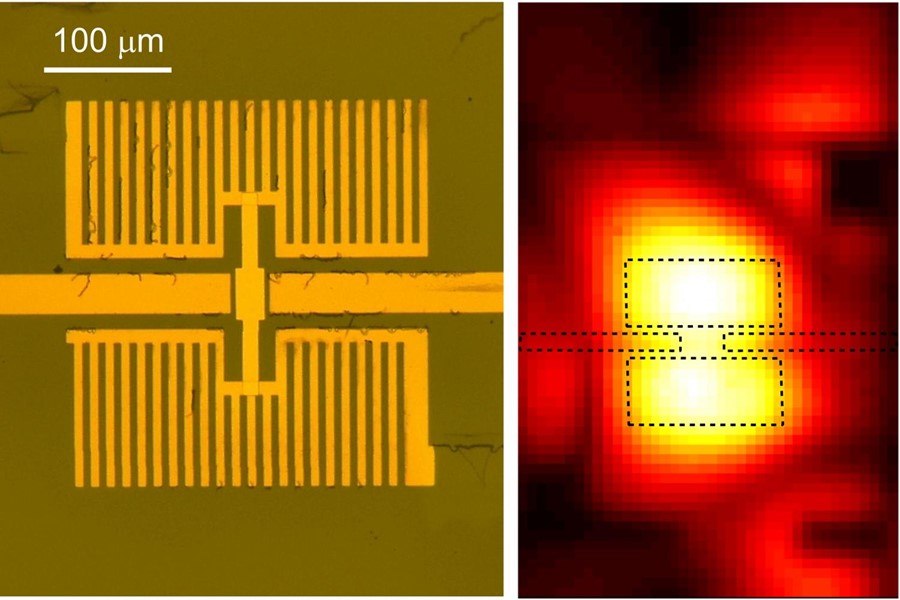Ultrahigh Sensitivity Graphene Infrared Detectors for Imaging and Spectroscopy
The graphene-based infrared detectors are ultra-sensitive thermometers, detecting minute changes in temperature. Image courtesy of Emberion.

Researchers from the Graphene Flagship, working at the University of Cambridge, UK, Emberion, UK, the Institute of Photonic Sciences (ICFO), Spain, Nokia UK, and the University of Ioannina, Greece have developed a novel graphene-based pyroelectric bolometer that detects infrared (IR) radiation to measure temperature with an ultrahigh level of accuracy. The work, published in Nature Communications, demonstrates the highest reported temperature sensitivity for graphene-based uncooled thermal detectors, capable of resolving temperature changes down to a few tens of µK. Only a few nano-Watts of IR radiation power are required to produce such a small temperature variation in isolated devices, about 1000 times smaller than the IR power delivered to the detector by a human hand in close proximity.
Pyroelectric Bolometers
The graphene-based devices consist of a pyroelectric substrate, with a conductive channel of single-layer graphene and a floating gate electrode placed on top. In pyroelectric materials, changes in temperature lead to a spontaneous electric field inside the material. The floating gate electrode concentrates this field on the graphene, and the field causes changes in the electrical resistance of the graphene, which are measured as the device output. Typical IR photodetectors operate either via the pyroelectric effect, or as bolometers, which measure changes in resistance due to heating. The graphene-based pyroelectric bolometers combine both effects for excellent performance and could be used as pixels in a high resolution thermal imaging camera.
Integration
Graphene acts as a built-in amplifier for the pyroelectric signal, without needing external transistor amplifiers as in typical pyroelectric thermal detectors. This direct integration means that there are no losses and no additional noise from connections to external amplifying circuits. "We can build the amplifier directly on the pyroelectric material. So, all the charge that it develops goes to the amplifier. There is nothing lost along the way," said Alan Colli (Emberion), co-author of the work.
The use of graphene also offers benefits for further integrating the detector pixels with the external readout integrated circuit (ROIC) used to interface with the detector pixels and the recording device. "To match the input impedance of the ROIC, you need something that is as conductive as possible. The intrinsic conductivity of graphene helps the further integration with silicon," said Colli. Impedance matching is essential to ensure that the signal is transmitted as efficiently as possible. This benefit is unique to graphene due to its combination of high conductivity and strong field effect.
Spectroscopy for Security Screening
The high sensitivity will be key for spectroscopic applications beyond thermal imaging, such as in security screening. Current IR photodetectors rely on integrated background IR radiation to provide a signal, and are not useful for spectroscopy. With a high-performance graphene IR detector that gives an excellent signal with less incident radiation, it is possible to isolate different parts of the IR spectrum. "With a higher sensitivity detector, then you can restrict the band and still form an image just by using photons in a very narrow spectral range, and you can do multi-spectral IR imaging. For security screening, there are specific signatures that materials emit or absorb in narrow bands. So, you want a detector that's trained in that narrow band. This can be useful while looking for explosives, hazardous substances, or anything of the sort," explained Colli.
Daniel Neumaier (AMO, Germany) is the leader of the Graphene Flagship Electronics and Photonics Integration Division. "The market size of IR detectors has increased dramatically in the last couple of years and these devices are entering more and more application areas. In particular, spectroscopic security screening is becoming more important," he said. "This requires high sensitivity under room temperature operation. The present work is a huge step forward in meeting these requirements in graphene-based IR detectors."
Frank Koppens (ICFO, Spain), Leader of the Photonics and Optoelectronics work Package and co-author of the work, added "One of the most promising applications of graphene is broadband photodetection and imaging. Combining visible and infrared detection in one material system is not possible with any other existing technology. The Graphene Flagship program will further build on this work to develop hyperspectral imaging systems, and exploit the directions where graphene is unique."
These devices are set to make a clear impact in IR spectroscopic imaging. Andrea Ferrari (University of Cambridge, UK), Science and Technology Officer of the Graphene Flagship, Chair of the Flagship Management Panel and co-author of the research, said "This work is another example of the steady march of graphene on the roadmap towards applications. Emberion is a new company created to produce graphene photonics and electronics for infrared photodetectors and thermal sensors, and this work exemplifies how basic science and technology can lead to swift commercialisation."
Further Reading
The Graphene Flagship program will further build on this work to develop hyperspectral imaging systems, and exploit the directions where graphene is unique."
Co-author



